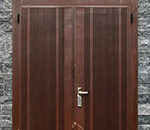There may be a lot to consider in setting up a day-to-night or night-to-day time lapse, but photographer Preston Kanak assures us that they aren’t as difficult to achieve as it may seem. In the video below, Kanak tells us everything we could possibly want to know about three different methods of timelapse, and how to work with the files in post:
1. Aperture Priority Method
This one has the advantage of being the simplest method to take on. You turn the camera to Aperture Priority mode, set the aperture and ISO for proper exposure, set your interval between shots, and fire away.

The simplest method: Aperture Priority
There are two big cons to this method, though. The first is that during the daylight portion of your time-lapse, you may end up with superfast shutter speeds (up to 1/8000), which can create a flicker effect on the final product. And then on the flip side, at night, your shutter speed may end up being longer than your interval. This results in less photos being taken during the night portion of the shoot, and you’ll end up with inconsistent smoothness of motion—the night scene will move more choppily than the day.
This is why it’s important to consider your interval time carefully. Do you want consistent motion throughout? Then choose an interval time that will be longer than your longest exposure. Would you rather have a quicker interval so that at least the daylight section will feature silky smooth motion? Then set it for 5 or 10 seconds and hope for the best. Another factor in interval time is how much storage you have on the camera’s memory card. If you’re going to take a 5 hour shot, and your interval is set for 10 seconds, you’ll need enough space for 1,800 pictures.
After you’ve decided on an interval, and set the exposure properly, there’s nothing left to do but wait. Kanak recommends checking the photos you’ve taken throughout the shoot to make sure exposure looks alright. If it doesn’t you can make adjustments midway through. When everything’s done, post process the images to correct for flicker or any other exposure issues.
2. Blend in Post mode
This is the more complicated option, but it’s the one Kanak recommends for getting a high quality time lapse. With this method, you actually take multiple time lapses—two is the minimum, but the more you take the better the final product. Kanak recommends at least one time lapse in full daylight, one during sunset, and one in the night. You put your camera in manual mode, and set your shutter, aperture, and ISO for proper exposure. The the interval is set—same considerations as above—and you shoot for a shorter period of time. You’ll need to babysit the camera, checking it periodically to see how the images are turning out, and adjusting any settings as necessary to maintain good exposure. When you’re all done, you should have 3 (or more) separate time lapses which you can blend together in post.
3. Bulb Ramping (aka Bramping)
This is Kanak’s least favorite method, and he doesn’t devote much time to explaining it. It requires purchasing a Bulb Ramper, which is essentially an intervalometer that will also adjust shutter speed based on settings. Since you can open the shutter for as long as you like in bulb mode, the Bulb Ramper has the ability to set shutter speeds down to the millisecond. This gets you a crazy amount of precision in setting your exposure. How easy or difficult this method is really relies on the Bulb Ramper you’re working with. Some will automatically adjust settings throughout the shoot, and some require manual intervention each time the light shifts and exposure needs to be adjusted. It can also limit your range of exposure settings, which means you’re going to take a hit on the range of light you can capture.
Like This Article?
Don't Miss The Next One!
Join over 100,000 photographers of all experience levels who receive our free photography tips and articles to stay current:






If you are a CANON user, consider Magic Lantern. It makes the event easier, even has bulb ramping built in.
for blending photos shot in Manual (or any other) I recommend to sue LRTimelapse.com which has a holy-grail feature and does the blending automatically (needs Lightroom).